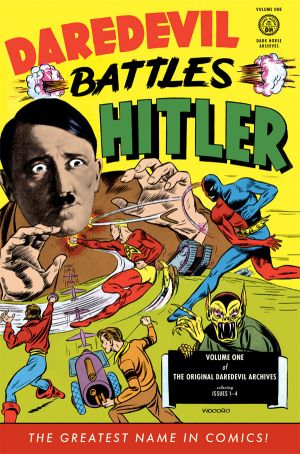Comics /
Comic Reviews /
More Comics
The Original Daredevil Archives Volume 1
By Clayton MacGillivray
July 10, 2013 - 12:52
Reprinting stories from the golden age of comics is always a gamble. With the good invariably comes some bad, and Dark Horse Comics’
The Original Daredevil Archives Volume 1 is no exception.
The archive reprints
Daredevil Comics 1 – 4 and includes, in addition to adventures starring the title character, stories featuring a host of lesser-known golden age heroes such as Silver Streak, Lance Hale and London. The stories themselves range from dark tales revealing the violence of war to slapstick portrayals of the Nazi command as buffoons to be mocked rather than feared.
Charles Biro and Bob Wood were the editorial voice behind these issues but producing a 64 page comic required a team of writers and artists, which, unsurprisingly, resulted in a mixed bag in terms of quality. For every strong, well articulated story or dynamic, nuanced panel of art there are just as many bland, uninspired pages. In two separate stories Daredevil uses Hitler as a punching bag and Lance Hale even shoots off the tyrant’s mustache with an arrow. In yet another story, Jack Cole pencils a Hitler who looks more like a silent movie villain than a despot. To his credit, Biro even demonstrates an understanding that not all Germans supported the Nazi regime by including a peg-legged worker who wishes that his people had the strength to crush Hitler themselves.
Unfortunately, these moments are undermined by several examples of the racism that haunts the comic book industry. In the Cole story, Japanese and Chinese soldiers and civilians are drawn as bucktoothed, squinty-eyed creatures that bare only a slight resemblance to human beings. When faced with an Italian navy twice the size of England’s, the British commander comments that these numbers make the battle even. Did Biro intend this as a compliment to Britain or a dig at Italy? He fails to give the Italians the same consideration he gave the Germans as the only voice heard is that of a weeping Benito Mussolini.
In many instances, the accounts of the individuals who crafted the pieces are more interesting than the stories that made it on to the pages of the book themselves. The assembly of issue two is legendary in comic circles and was detailed in Gerard Jones’ Men of Tomorrow: Geeks, Gangsters and the Birth of the Comic Book. Given three days to complete the book, Biro and Wood brought in Jerry Robinson, Bernie Klein, Mort Meskin, George Roussos and Biro’s brothers, Dick and Dave to help. The eight young men, all early in their careers, hunkered down in Biro’s studio and pounded out the pages despite running out of food and being trapped by a raging snow storm until at last the work was finished and sent to print.
In light of such a tight deadline some weak art or plot holes can be forgiven. But exactly how much accommodation should be made by the reader for the climate and constraints under which these books were made? This is a question each reader must answer for themselves.
Ultimately, what the Daredevil archive provides is a time capsule of the comic book industry at a time when the medium was young and the genre of the superhero was in its infancy. A time when the story telling ‘rules’ were not so rigid and a hero could punch a dictator in the face and simply walk away.
Last Updated: January 17, 2025 - 08:20
